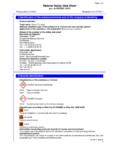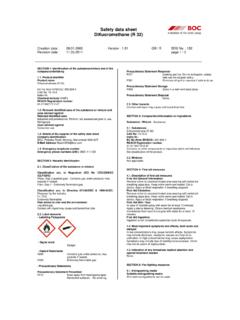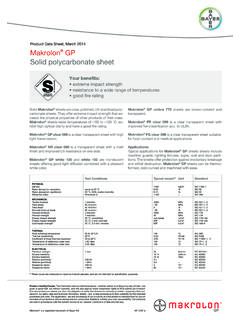Transcription of Acceptable Container Condition.
1 ACC 1 ACC Acceptable Container Condition. International Tank Container Organisation. ACC 2 International Tank Container Organisation. Suite 3, Charter House, 26, Claremont Road, Surbiton, KT6 4QZ. United Kingdom. ITCO Secretary. Patrick Hicks. Email: ITCO ACC Edition September 2017 ACC 3 Liability Exclusion. These guidelines were prepared with industry consultation. Acceptable Container Condition is a general inspection guide and does not apply to a specific tank design. The guidelines are intended for professionals only, qualified inspectors who have completed appropriate training, including training in health and safety requirements.
2 ACC does not take precedence over any contractual terms between parties, statutory regulation or the requirements of the Competent Authority. Shippers, operators, carriers, service providers and others should carry out their own risk assessment of all matters contained within these guidelines and ensure the tank is fit for purpose, safe and reliable for transport and in accordance with the regulations. The International Tank Container Organisation offer no warranty in relation to the completeness and accept no liability whatsoever for any events resulting from use of ACC Inspection Guidelines. ACC 4 Contents. i. Introduction. i. Health and Safety. iii. Definitions. iv. Cleaning terminology.
3 1. Cleanliness. 2. Frame. 3. Paintwork. 4. Walkway and Ladder. 5. Insulation and Cladding. 6. Spillage compartments. 7. Manway Assembly. 8. Pressure Relief Device. 9. Top Valves. 10. Tank shell (Pressure Vessel). 11. Bottom Valves. 12. Heating. 13. Markings. 14. Miscellaneous. 15. Test. Appendix. A Cleanliness Certificate. B Internal Inspection Report. C Standard Seals and Gaskets. D Paintwork, Corrosion. ACC 5 ii. Introduction. This 4th edition dated September 2017 ACC Inspection Guideline is published by the International Tank Container Organisation. It supersedes all previous editions. The objective of ACC is to establish an in-service inspection benchmark for an Acceptable condition of a general purpose tank.
4 ACC recommends when the condition of a tank component should be repaired. ACC is designed for use when tanks are inspected at the time of interchange between one party to another, such as between owner, operator, lessee, shipper, depot and carrier. This will include, for example, inspections undertaken at the 'on-hire' or off-hire of a leased Container . ACC is not intended to imply an Acceptable condition at time of manufacture or the quality of a repair. ACC does not take precedence over any regulation, Competent Authority Directive, Health and Safety requirement or other governmental requirements. ACC inspection guideline covers, primarily stainless steel UN Portable Tank T11 but it is also generally applicable to most tanks designed for transporting liquid substances T1 T22.
5 The term tank is used within ACC to include portable tank, tank Container , swap tank. The term owner is used to describe the entity responsible for the tank at the time of the inspection. In this context it may be the owner, lessor, lessee, operator, shipper or other party. Regulations, where mentioned, refer to IMDG but ACC might generally apply to other regulations to which the ACC 6 tank is specified. For specific requirements, the inspector should refer to the regulation. ACC does not take precedence over technical or commercial requirements or agreements entered into between contracting parties. Tanks might be fitted with equipment outside the scope of ACC or not fully covered by ACC.
6 The inspector should verify items of the tank specification with the tank owner as might be appropriate. The inspector should contact the tank owner when it is necessary to seek information concerning the tank specification, manufacturers manual or certification. Any drawings or photographs included within ACC are for descriptive purposes only. Although ACC includes notes regarding repair, it is not designed to determine the repair. The qualified repairer should recommend the repair procedure in line with industry best practice, normally like for like repair as new to the original specification and manufacturers recommendations. Repairs and replacement parts, including valves, fittings and pressure relief devices (safety valves) should be undertaken to the manufacturers recommendations.
7 The tank user should carry out a risk assessment and ensure the tank is fit for purpose, safe and reliable for transport and in accordance with the regulations. ACC 7 iii. Health and Safety. All personnel undertaking these inspection guidelines should be trained in Health and Safety requirements in accordance with the Governmental regulations and Company Policy Do not any operate valves or fittings or enter into any tank that has not been issued with a valid tank entry permit. Ensure safe inspection procedures and practice according to Health and Safety regulations and requirements and the SDS (Safety Data Sheet). Undertake a risk assessment, proceed only when safe. iv.
8 Definitions. The inspection guide that follows lists the component parts of a tank Container and defines the Tank Acceptable Container Condition (ACC) criteria for: Not Acceptable damage. Acceptable damage. NOT Acceptable Condition. Is damage that affects the safety, structural integrity, cargo-carrying capability or the ISO dimensional integrity of the tank. This type of damage should be repaired Acceptable Condition. Is damage that does not affect any of the above conditions and therefore: No repair is required. ACC 8 Terminology. Damages are described within ACC according to the terminology and damage code provided by ISO 9897 (CEDEX) Container equipment data exchange.
9 Other comparable terminology and damage codes may be in common industry use. Bent (BT) Component is damaged by being bent deformed. Bowed (BW) Component is damaged by being bowed damage is gradual over the length of the component. Broken/split (BR) Component is damaged by being broken or split. Contaminated (CT) Equipment is rendered unsuitable for cargo because of contamination by chemicals or other cargo products. Corroded/rusty (CR) Component is corroded or rusty. Corroded/holed (CO) Component is holed by corrosion. Cracked (CK) Crack apparent either in surface or through part or all of component profile. Cracked weld (CW) Welding seam is damaged by being cracked. Dent (DT) Component is damaged by being dented a localised and often acute angled depression.
10 Foreign marks (ML) Labels, marks, logos, and graffiti, etc. not required by the owner. Improper Cleaning (IC) The component has had an inadequate cleaning procedure performed. ACC 9 Improper repair (IR) A repair that does not conform to owner's requirements or industry standards because the quality or condition could be defined as NOT Acceptable Condition due to, for example, its reduced structural strength, quality, improper materials or abrasive polishing of the shell. If an existing improper repair is evaluated to be otherwise technically Acceptable , no rework is necessary. If the improper repair results from a current in progress repair, it is not Acceptable . Loose (LO) the component is loose.






